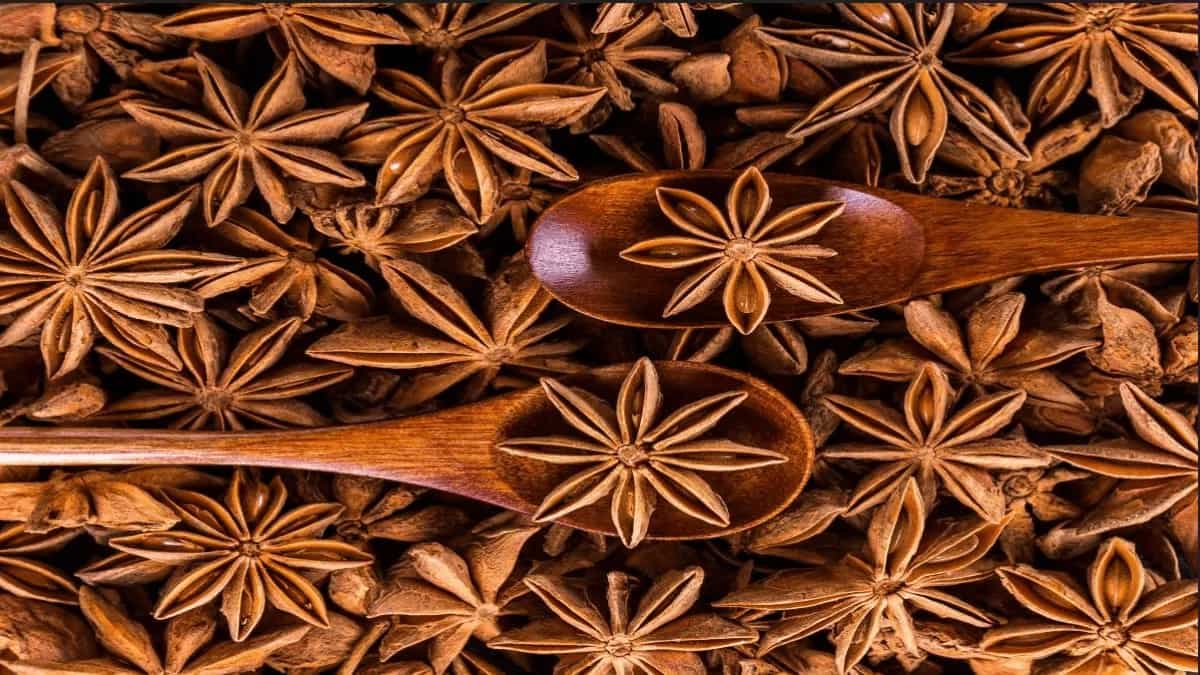There are several names for the spice Illicium verum, or star anise: Chakra Phool, Chakra Phool, and Chakri Phool. One can't imagine cooking decadent pulao recipes in India without this spice. Justifying its name, it literally becomes the star of the fragrance. Its application transcends Indian borders, as the use of star anise is a hallmark of authentic Chinese savoury dishes. There has been a profuse of this condiment in traditional Chinese cooking, and star anise is used in the five-spice powder blend. This pretty-looking condiment has several fascinating facets about it. Let's get to know it better.
Stunning appearance
The dried, star-shaped fruit of the Illicium verum tree is known as the star anise. It's an evergreen tree that can grow 8-15 metres tall and 25 cm wide. Flowers are single and can range in colour from white to scarlet; the leaves are elliptic and whole and are 10-15 cm in length and 2.5-5 cm in width. The fruit is a reddish-brown star with six to eight carpels grouped in a whorl. Each carpel is a boat-shaped, rigid, wrinkled 10 mm long structure that contains a single seed. The seeds are fragile and come in brown with these characteristics: they are compressed, ovoid, smooth, shiny, and packed.
Origin and indigenousness
Originating in Southeastern China, star anise has been a native condiment. Initially, it was used in this country as a spice and for healing or medicinal purpose for around 3000 years. Star anise arrived in Europe in the late 1500s via an English sailor and was extensively traded from China via Russia. The sweet flavour of star anise led to its primary use in jams, syrups, and puddings. Later, it was employed in place of anise seed in commercial beverages.

Star anise spice, Image Source: Pexels
Its production is primarily restricted to China and Vietnam. Only the hilly state of Arunachal Pradesh cultivates a tiny amount of it in India. Many countries have tried and failed to grow star anise since the crop demands unique agroclimatic conditions found exclusively in traditional growing areas. The forests, sunny margins, and dappled shade are its preferred habitats. It thrives in humus-rich, slightly acidic to neutral, light to medium, well-drained soils. It can stay functional at temperatures as low as -10 degrees Celsius.
Culinary usage
As mentioned above, star anise is one of the most distinctive flavours in Chinese savoury cuisine. It is an ingredient of China's standard five-spice powder blend. Star anise adds flavour to vegetables and meat, and it's also used as a marinade. Curries, sweets, liqueurs, and pickles all benefit from its addition. Chinese chefs use it to season roast duck and other foods and prepare tea. Star anise is used in the famous Vietnamese soup pho. It is more commonly employed in Western countries to flavour liqueurs such as absinthe, sambuca, pastis, and cookies and cakes.

Eight-carpels star anise, Image Source: Pexels
Star anise essential oil adds flavour to various foods and drinks, including carbonated beverages, baked goods, and alcoholic beverages. As a fruit, it is popular in culinary realms and imperative to indigenous medical practices. Its properties make it antibacterial, carminative, diuretic, and stomachic. It's beneficial for spastic colon and bloating. Star anise oil has several uses in traditional medicine, including as a digestive aid, an expectorant, a stimulant, and a tonic for the central nervous system. B-complex vitamins, including pyridoxine, niacin, riboflavin, and thiamin, can all be found in high concentrations in the seeds.
Global culinary terms
One would be amazed to know several monikers for this condiment. In India alone, it is called Anasphal in Hindi, Takkolam in Malayalam, Badian in Marathi, Anasphul in Oriya, and Anashuppu in Tamil, Anaspuvu in Telugu and Badyani in Urdu. Ba jiao in Chinese, Badyan in Czech, Steranijs in the Dutch language, Anis de la Chine in French, and Sternanis in German are all names for it. In Indonesia, it is known as Bunga Lawang, Anice Stellato in Italian, Badyan in Russia and Spanish calls it Badian and Nepalese know it as star phul.


